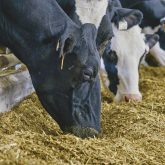U.S. federal trade officials plan a whole other challenge of Canada’s allocations of tariff rate quotas (TRQs) on U.S. dairy imports — on top of a challenge they’re already seeking — saying they’ve now found Canada’s revised policies are problematic in new and different ways.
Canada in May published revisions of its TRQ allocation policies after a January ruling by a dispute settlement panel under the Canada-U.S.-Mexico free trade agreement (CUSMA) — the first such dispute to be heard since CUSMA took effect in 2020.
Read Also

U.S. livestock: Feeder cattle hit contract highs on tight supply
Chicago | Reuters – All Chicago Mercantile Exchange feeder cattle futures and most live cattle futures hit contract highs on…
The January ruling had found Canada was violating CUSMA rules by reserving most of its TRQs for Canadian processors. The new policies Canada published in May were intended to “end the use of processor-specific TRQ pools,” Canada’s Trade Minister Mary Ng said at the time.
Canada’s supply management system for dairy farmers relies on a tariff wall that effectively limits imports from the U.S. and elsewhere. CUSMA, which was expected to improve U.S. dairy producers’ market access to Canada, maintains Canada’s right to 14 dairy-related TRQs on products including milk, cream, ice cream, milk powders, cheeses, condensed milk, yogurt and buttermilk, among others.
A TRQ is a trade mechanism that allows an agreed-upon amount of a specified product to be imported with low or no duties. Beyond that amount, a different and usually higher duty is applied.
Importers who want to use the U.S. product can seek an allocation that allows them to bring in up to a certain amount under the TRQ, after which their imports would be subject to the higher over-quota duty. Thus, if an importer is granted an allocation for, say, 100,000 kg of U.S. cheese under a TRQ, he or she can bring it all in at once or draw down on his or her allocation in portions over the course of a calendar year.
The week after Canada’s revised dairy TRQ rules were published in May, U.S. Trade Representative (USTR) Katherine Tai’s office said it would seek trade consultations a second time, arguing that the new TRQ rules still keep some eligible applicants, such as retailers and foodservice operators, from getting TRQ allocations.
Now, however, the USTR and U.S. Department of Agriculture said Tuesday, “since initiating those consultations, the United States has identified additional areas of deep concern, and this new request for consultations provides an avenue to formally address U.S. concerns” — after which the U.S. said it may seek another CUSMA dispute panel if its concerns aren’t addressed.
‘Ring-fencing’
Canada’s revised TRQ policy still denies access to allocations for “all types of importers except for processors, distributors, and, in some cases, further processors,” USTR and USDA said Tuesday.
But they said “additional aspects” of Canada’s TRQ allocation measures are also inconsistent with Canada’s CUSMA obligations.
Canada, they said, allocates its product-specific dairy TRQs based on a calculation of an applicant’s market share, and the math used to do so differs depending on the type of applicant, “which has the effect of ring-fencing large shares of the quota and limiting access to those shares exclusively to processors.”
Canada also requires that applicants “be active during all 12 months of a 12-month reference period, potentially excluding otherwise eligible applicants, in particular new entrants,” the agencies said.
Also, Canada’s “turnback” policy, for the return and reallocation of unused allocations, now allows for the return of allocations without potential penalty and late in the TRQ year, USTR and USDA said.
Specifically, USTR said in Tuesday’s request for consultations, Canada allows for allocation holders to return their unused allocations without penalty for the first eight months of a TRQ year.
Which means, the U.S. agencies alleged Tuesday, that there’s no mechanism for unused quota allocations to come back for reallocation in a “timely and transparent” way that allows the “greatest possible opportunity” for a TRQ to be filled.
“Rather than work toward meeting its obligations, Canada persists in implementing new dairy policies that are inconsistent with (CUSMA), and which continue to deny U.S. workers, farmers, producers, and exporters the full benefits of market access they were initially promised,” Tai said Tuesday.
“Canada remains in violation of its commitments under (CUSMA) by not removing its trade restrictions on American dairy producers,” U.S. Agriculture Secretary Tom Vilsack said in the same release.
Ng, in a statement Tuesday, replied that dispute settlement panels “have confirmed that our supply management system is in line with our international trade obligations. The terms that we negotiated under (CUSMA) are being respected and upheld.”
The Canadian government, Ng said, “look(s) forward to demonstrating how Canada is meeting its CUSMA obligations during the new consultations on allocations of dairy tariff rate quotas.” — Glacier FarmMedia Network

















